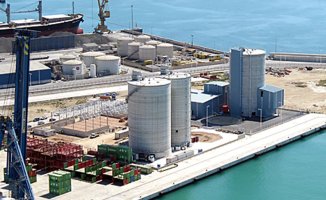Extreme heat, thermometers above 40 degrees, forest fires, droughts, melting glaciers... summer in different regions of the planet is red hot and meteorologists announce that this climate change is here to stay.
We are (logically) so focused on what is being lost that sometimes we do not realize what is being rediscovered in the same process: ancient cities, ghost towns, shipwrecks, corpses or ornamental gardens see the sun again after decades disappeared.
In Spain, without having to go very far, an entire town has resurfaced in Galicia. Aceredo, located near the border with Portugal, was flooded in 1992 to make way for the Alto Lindoso reservoir. Some 30 years later, last February, the drought once again exposed their houses frozen in time, causing a massive influx of tourists.
Months without rain in Italy and the interruption of the usual melting flows from the Alps have pushed the Po River, the country's longest, to its lowest level in 70 years. When its bed dried, it revealed previously hidden World War II remnants such as a German tank and cargo ships.
Meanwhile, in Rome, the drought sapped the Tiber River and uncovered a bridge believed to have been built during Emperor Nero's rule. Extremely hot and dry conditions this summer forced the Italian government to declare a state of emergency in July.
Some reservoirs in the United States that should now be overflowing from melting snow in the spring have their land dry, including Lake Mead. The largest man-made reservoir in the United States fell this year to an all-time low.
Located between the states of Nevada and Arizona, in close proximity to the iconic Hoover Dam, Lake Mead has been reduced to a fraction of its former self to become a site of macabre curiosity.
Visitors have found everything from sunken ships to dead bodies. "We could find anything from a lost jet ski to bodies," Michael Green, an associate professor of history at the University of Las Vegas, told Bloomberg. "As the water recedes, we will find more," he added.
Human remains discovered at the site include a body inside a barrel, the National Park Service revealed. The victim's cause of death is still under investigation.
On February 25, the Antarctic sea ice cover shrank to a record level, which may have helped solve one of the biggest mysteries in maritime history, the wreck of the Endurance.
A group of scientists set out on a research ship from South Africa to the depths of the Weddell Sea, a remote area of the Antarctic coast, to locate, inspect and film the remains of Sir Ernest Shackleton's ship. For a long time the exact whereabouts of the famous explorer's ship that was crushed by thick sea ice in 1915 was unknown.
The 35-day mission was tough. The team had to navigate choppy waters and deal with ice, which was still very dangerous even though it was below average. Using an autonomous vehicle, they found the wreck more than 3,000 meters underwater.
The extreme heat of summer in the UK caused a fire in a historic house in central England, revealing a hidden 17th-century garden. Wide, ornate patterns can be seen on the lawn at Chatsworth House in Derbyshire.
Nicknamed the Great Parterre, the sprawling garden dates back to 1699 and was once filled with flowers and paths. By 1730, the ornate landscape was covered with grass. On July 26, Chatsworth registered a temperature of 38.1 ℃, the highest recorded in more than 100 years, according to the website of the historic house.
An important city of a Bronze Age empire has reappeared in Iraq, in an area that has dried up near Mosul. A team of Kurdish and German archaeologists hastened to investigate the site of Kemune, an ancient site on the Tigris River that flourished under the Mitanni Empire during the Bronze Age.
The research team found ceramic vessels that allegedly contained more than 100 cuneiform tablets. The discovery could provide further details about the end of the city and the beginning of Assyrian rule in the region.
"It is almost a miracle that cuneiform tablets made of unfired clay survived so many decades underwater," said University of Tübingen professor Peter Pfälzner, who was part of the rescue excavations.
In the high mountains of Norway, artifacts discovered by archaeologist Lars Pilø and his team in the Glacier Archeology Program included an Iron Age woolen tunic, as well as a Roman-style flip-flop and a well-preserved arrow with still-feathered feathers. attached from the years 300 to 600. The arrow is a relic from a reindeer hunting site.
“With continued high-mountain ice melting, we hope to see older finds appear,” said Pilø, whose team has found thousands of items from the Iron Age and early medieval period at ice sites in Norway over the past 15 years. . "We are going back in time as the ice melts," said the researcher.













